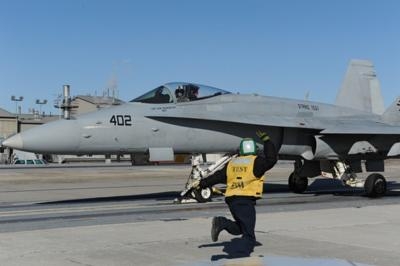EMALS Launches Legacy Hornet In Final Ground-Based Compatibility Test
The past and future overlapped recently on a land-based test site at Joint Base McGuire-Dix-Lakehurst, New Jersey, when the near-silent armature of the U.S. Navy’s new Electromagnetic Aircraft Launch System (EMALS) propelled an F/A-18C Hornet.

EMALS — the newest carrier catapult technology in 60 years — completed the second and final phase of aircraft compatibility testing (ACT) this spring with the first-ever launches of the legacy Hornet, that marked the 35th anniversary of its inaugural flight last year. “This is an amazing and pivotal time for naval aviation,” said Capt. Frank Morley, who leads the F/A-18 and EA-18G Program Office (PMA-265). “Who would have thought 35 years ago that the Hornet would launch from anything other than steam catapult technology. We are fortunate to witness this historic milestone.”
EMALS is replacing the steam launch system beginning with the new Ford-class carriers. USS Gerald R. Ford (CVN 78) is under construction at the Huntington Ingalls Industries shipyard in Newport News, Virginia, where nearly all EMALS hardware components have been delivered and installed. “The successful manned-aircraft test launches replicated various carrier situations to demonstrate that the catapult would provide the required aircraft end-speed and to validate EMALS launch-critical reliability,” said George Sulich, EMALS integrated test team lead.
The first phase of ACT successfully ended in fall 2011 with 134 manned aircraft launches, comprising the F/A-18E Super Hornet, T-45C Goshawk, C-2A Greyhound, E-2D Advanced Hawkeye and F-35C Lightning II.
ACT phase two, which concluded April 6, included launches of the EA-18G Growler and F/A-18C Hornet, and another round of launches with the current carrier-deployed aircraft that completed ACT phase one.
The program office concluded ACT with 452 manned launches and, for the last several months, has been busy delivering the final components of the system to CVN 78. “It’s an exciting time for EMALS. We’re very pleased to be this close to delivering EMALS to the United States Navy,” said Capt. Jim Donnelly, program manager for the Aircraft Launch and Recovery Equipment Program Office (PMA-251), adding that CVN 78 is projected to deliver in spring 2016, and at-sea EMALS aircraft launches will begin shortly thereafter.
Starting in late 2015, the ship is scheduled to launch dead-loads, or weighted sleds, from the system, leading up to manned launches after delivery.
More than 25 years of technology development has gone into EMALS, resulting in the current configuration being installed on CVN 78. “EMALS was facing reliability questions in 2008, and the program has rebounded from these early struggles and is now in a good place to deliver the fleet a robust next-generation, carrier-launch system,” said Rear Adm. Donald Gaddis, Program Executive Officer for Tactical Aircraft (PEO(T)), which oversees PMA-251.
EMALS is a complete carrier-based launch system, designed to expand the operational capability of the Navy’s future carriers to include all current and future planned carrier air wing platforms – from lightweight unmanned to heavy strike fighters. It delivers necessary higher-launch energy capacity; substantial improvements in system maintenance; increased reliability and efficiency; and more accurate end-speed control, with a smooth acceleration at both high and low speeds.
“With each passing test day, the system continues to prove its reliability and demonstrate the advantages it brings to the fleet,” Donnelly said. “The whole EMALS team has done a fantastic job in the last few years to make this technology a reality.”
(Image provided by the U.S. Navy)
 ANN's Daily Aero-Term (05.05.24): Omnidirectional Approach Lighting System
ANN's Daily Aero-Term (05.05.24): Omnidirectional Approach Lighting System Aero-News: Quote of the Day (05.05.24)
Aero-News: Quote of the Day (05.05.24) Airborne 05.06.24: Gone West-Dick Rutan, ICON BK Update, SpaceX EVA Suit
Airborne 05.06.24: Gone West-Dick Rutan, ICON BK Update, SpaceX EVA Suit Airborne 05.03.24: Advanced Powerplant Solutions, PRA Runway Woes, Drone Racing
Airborne 05.03.24: Advanced Powerplant Solutions, PRA Runway Woes, Drone Racing Aero-News: Quote of the Day (05.06xx.24)
Aero-News: Quote of the Day (05.06xx.24)



